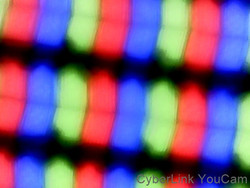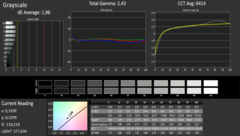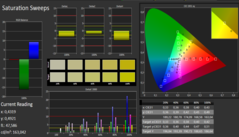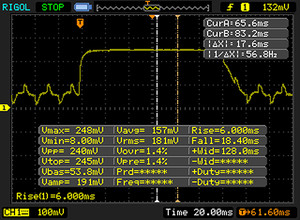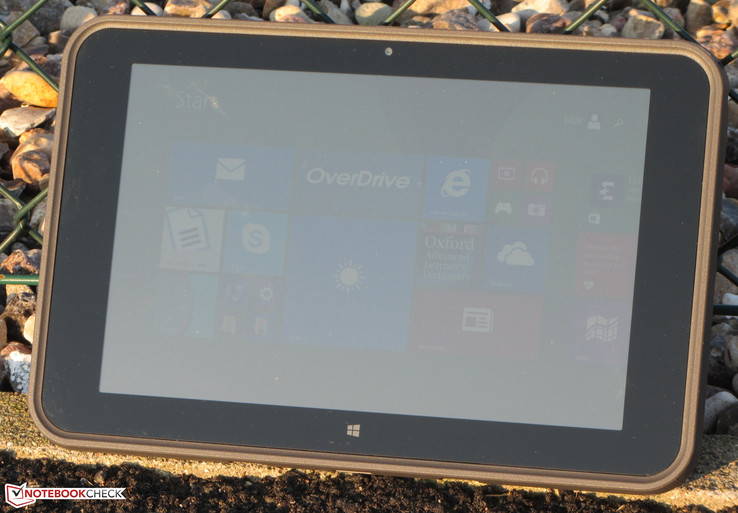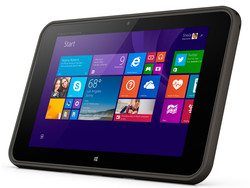HP Pro Tablet 10 EE G1 Tablet Review

For the original German review, see here.
HP's tablet has been on the market for many months now. Thus, inside it has a Bay Trail processor rather than a model of the succeeding Cherry Trail generation. This is not a problem because the performances of the CPUs are quite similar. Rivals for this tablet include Lenovo's ThinkPad Tablet 10, Google's Pixel C or even Apple's IPad Air 2.
Case & Connectivity
The tablet's casing is made of plastic. The sides of the device are encased in a thick, gray rubber layer to protect the tablet from drops and shocks. Even the screen should remain undamaged when the tablet is dropped on its side. No flaws can be found in the build quality. The tablet could have been rather more robust for our taste. The tablet's interfaces are hidden behind a flap that protects them against moisture. The standard ports familiar from most other tablets are found here. The installed micro-USB port serves as the connector for the power supply. The small, handy power supply does not need much room. The power cable's length of approximately one meter (~3.3 ft) is too short.
The tablet is equipped with a 64-bit processor. However, HP has installed the 32-bit version of Windows 8.1 Pro (64-bit). This is because the 32-bit version is easier on resources. We upgraded to Windows 10 for a test. This was easy. All hardware components were identified.
Input Devices
The tablet's touchscreen responds instantaneously to inputs; we did not encounter any problems. It supports 10 touch points. In addition to the fingers, the tablet can be used with the supplied stylus. It is a simple plastic model and not an active, pressure sensitive pen.
Display
The tablet's 10.1-inch screen has a native resolution of 1280x800 pixels. Both the screen's brightness (356.9 cd/m²) as well as the contrast (949:1) are appealing. Unfortunately, it exhibits PWM flickering at a frequency of 200 Hz in brightness levels of 95% and lower. This could lead to headaches and eye problems in sensitive users.
| |||||||||||||||||||||||||
Brightness Distribution: 71 %
Center on Battery: 301 cd/m²
Contrast: 949:1 (Black: 0.41 cd/m²)
ΔE ColorChecker Calman: 4.64 | ∀{0.5-29.43 Ø4.78}
ΔE Greyscale Calman: 1.96 | ∀{0.09-98 Ø5}
60% sRGB (Argyll 1.6.3 3D)
38% AdobeRGB 1998 (Argyll 1.6.3 3D)
41.81% AdobeRGB 1998 (Argyll 3D)
60.3% sRGB (Argyll 3D)
40.47% Display P3 (Argyll 3D)
Gamma: 2.43
CCT: 6414 K
Screen Flickering / PWM (Pulse-Width Modulation)
| Screen flickering / PWM detected | 200 Hz | ≤ 95 % brightness setting | |
The display backlight flickers at 200 Hz (worst case, e.g., utilizing PWM) Flickering detected at a brightness setting of 95 % and below. There should be no flickering or PWM above this brightness setting. The frequency of 200 Hz is relatively low, so sensitive users will likely notice flickering and experience eyestrain at the stated brightness setting and below. In comparison: 53 % of all tested devices do not use PWM to dim the display. If PWM was detected, an average of 8108 (minimum: 5 - maximum: 343500) Hz was measured. | |||
IIn state of delivery, the DeltaE 2000 color deviation is 4.64, which misses the target range (DeltaE less than 3) just marginally. The screen does not have a bluish tint. Positive: The reproduction of the grayscale levels is quite balanced.
Display Response Times
| ↔ Response Time Black to White | ||
|---|---|---|
| 24 ms ... rise ↗ and fall ↘ combined | ↗ 6 ms rise | |
| ↘ 18 ms fall | ||
| The screen shows good response rates in our tests, but may be too slow for competitive gamers. In comparison, all tested devices range from 0.1 (minimum) to 240 (maximum) ms. » 53 % of all devices are better. This means that the measured response time is worse than the average of all tested devices (20.2 ms). | ||
| ↔ Response Time 50% Grey to 80% Grey | ||
| 34 ms ... rise ↗ and fall ↘ combined | ↗ 14 ms rise | |
| ↘ 20 ms fall | ||
| The screen shows slow response rates in our tests and will be unsatisfactory for gamers. In comparison, all tested devices range from 0.165 (minimum) to 636 (maximum) ms. » 45 % of all devices are better. This means that the measured response time is similar to the average of all tested devices (31.6 ms). | ||
Performance
HP's Pro 10 EE G1 tablet is a 10.1-inch tablet designed for educational institutions. Our review sample's price starts at approximately 500 Euros (~$544). Other configurations are also available; the cheapest model without the 3G modem costs around 430 Euros (~$468). The tablet is also available with an Android operating system in which case it is called HP ProSlate 10 EE G1.
Processor
The tablet is powered by Intel's Atom Z3735F (Bay Trail) quad-core processor. It’s low TDP (<4 watts) allows passive cooling. The processor clocks at a base speed of 1.33 GHz, which can be boosted to 1.83 GHz via Turbo. The Turbo is utilized partially. The processor performed our CPU test mostly at 1.58 GHz. This applies to both AC and battery mode.
| Cinebench R10 | |
| Rendering Multiple CPUs 32Bit | |
| Lenovo IdeaPad Miix 300-10IBY | |
| HP Pro Tablet 10 EE G1 | |
| Lenovo Thinkpad Tablet 10 2nd Gen | |
| Rendering Single 32Bit | |
| Dell Venue 11 Pro 5130-9356 | |
| Lenovo Thinkpad Tablet 10 2nd Gen | |
| Lenovo IdeaPad Miix 300-10IBY | |
| HP Pro Tablet 10 EE G1 | |
| Geekbench 3 | |
| 32 Bit Single-Core Score | |
| HP Pro Tablet 10 EE G1 | |
| Acer Iconia Tab 10 A3-A30 | |
| Lenovo IdeaPad Miix 300-10IBY | |
| 32 Bit Multi-Core Score | |
| HP Pro Tablet 10 EE G1 | |
| Lenovo IdeaPad Miix 300-10IBY | |
| Acer Iconia Tab 10 A3-A30 | |
| Sunspider - 1.0 Total Score | |
| Acer Iconia Tab 10 A3-A30 | |
| Google Pixel C | |
| HP Pro Tablet 10 EE G1 | |
| Lenovo IdeaPad Miix 300-10IBY | |
| Lenovo Thinkpad Tablet 10 2nd Gen | |
| Apple iPad Air 2 2014 | |
| JetStream 1.1 - Total Score | |
| Google Pixel C | |
| Lenovo IdeaPad Miix 300-10IBY | |
| HP Pro Tablet 10 EE G1 | |
| Mozilla Kraken 1.1 - Total | |
| HP Pro Tablet 10 EE G1 | |
| Lenovo IdeaPad Miix 300-10IBY | |
| Google Pixel C | |
| Acer Iconia Tab 10 A3-A30 | |
| Lenovo Thinkpad Tablet 10 2nd Gen | |
| Apple iPad Air 2 2014 | |
| Octane V2 - Total Score | |
| Apple iPad Air 2 2014 | |
| Lenovo Thinkpad Tablet 10 2nd Gen | |
| Google Pixel C | |
| Acer Iconia Tab 10 A3-A30 | |
| Lenovo IdeaPad Miix 300-10IBY | |
| HP Pro Tablet 10 EE G1 | |
| Peacekeeper - --- | |
| Apple iPad Air 2 2014 | |
| HP Pro Tablet 10 EE G1 | |
| Lenovo IdeaPad Miix 300-10IBY | |
* ... smaller is better
System Performance
The system runs smoothly; we did not encounter any problems. The PCMark benchmark scores correspond to the performance of the installed SoC. A look at our comparison chart reveals that comparable devices based on Cherry Trail processors (Bay Trail successors) score better. This is due to their considerably stronger graphic cores. At the same clock speeds, the processors' performances differ marginally at most. The system performance of HP's tablet cannot be further improved.
| PCMark 8 Home Score Accelerated v2 | 1106 points | |
| PCMark 8 Creative Score Accelerated v2 | 950 points | |
| PCMark 8 Work Score Accelerated v2 | 1161 points | |
Help | ||
| PCMark 8 - Work Score Accelerated v2 | |
| Lenovo Thinkpad Tablet 10 2nd Gen | |
| Dell Venue 11 Pro 5130-9356 | |
| HP Pro Tablet 10 EE G1 | |
| Lenovo IdeaPad Miix 300-10IBY | |
Storage Device
The tablet is equipped with an eMMC storage device that has a capacity of 32 GB. Approximately 17 GB of that can be used in the state of delivery. The remaining storage is reserved for the Windows installation and recovery partition. The module's transfer rates are on par for this kind of storage.
Graphics Card
The installed Intel HD Graphics core supports DirectX 11 and clocks at speeds of up to 646 GHz. The 3DMark benchmark scores are on par for the GPU installed here. The results are at the lower end of the performance scale.
| 3DMark 11 Performance | 203 points | |
| 3DMark Ice Storm Standard Score | 11788 points | |
| 3DMark Cloud Gate Standard Score | 1027 points | |
Help | ||
| 3DMark 11 - 1280x720 Performance | |
| Lenovo Thinkpad Tablet 10 2nd Gen | |
| Lenovo IdeaPad Miix 300-10IBY | |
| HP Pro Tablet 10 EE G1 | |
| Dell Venue 11 Pro 5130-9356 | |
| 3DMark | |
| 1280x720 Ice Storm Standard Score | |
| Lenovo IdeaPad Miix 300-10IBY | |
| HP Pro Tablet 10 EE G1 | |
| Lenovo Thinkpad Tablet 10 2nd Gen | |
| Google Pixel C | |
| 1280x720 Cloud Gate Standard Score | |
| Lenovo IdeaPad Miix 300-10IBY | |
| HP Pro Tablet 10 EE G1 | |
| Lenovo Thinkpad Tablet 10 2nd Gen | |
| 1280x720 Sky Diver Score | |
| Lenovo IdeaPad Miix 300-10IBY | |
| HP Pro Tablet 10 EE G1 | |
Gaming Performance
The performance of the tablet's hardware is much too weak for most games. Only a handful of games can be rendered smoothly. Games suitable for the tablet can be found in the Windows Store under casual games.
| low | med. | high | ultra | |
|---|---|---|---|---|
| Trackmania Nations Forever (2008) | 42.9 | 10.3 |
Emissions & Energy
HP's tablet performed our stress test (Prime95 and FurMark run for at least one hour) in the same manner in both AC and battery mode. The CPU clocks mostly at a speed of 1.33 GHz. It throttled for a moment (<1 second) in the course of the test. The graphics core continuously clocks at 300 to 340 MHz. The device does not heat up excessively. 40 degrees Celsius (~104 degrees Fahrenheit) was exceeded on three measuring points.
(+) The maximum temperature on the upper side is 39 °C / 102 F, compared to the average of 33.7 °C / 93 F, ranging from 20.7 to 53.2 °C for the class Tablet.
(±) The bottom heats up to a maximum of 44.9 °C / 113 F, compared to the average of 33.2 °C / 92 F
(+) In idle usage, the average temperature for the upper side is 27.8 °C / 82 F, compared to the device average of 30 °C / 86 F.
Speaker
Power Consumption
We measured a maximum idle consumption of 5.7 watts - a normal rate for the platform installed here. The rate climbed to 12.2 watts in the stress test. The power supply has a nominal output of 18 watts.
| Off / Standby | |
| Idle | |
| Load |
|
Key:
min: | |
Battery Runtime
Our practical Wi-Fi test simulates the load needed for opening websites. The "Balanced" profile is enabled, and the screen's brightness is set to approximately 150 cd/m². HP's tablet achieved a runtime of 7:44 hours - enough for a school day.
Pros
Cons
Verdict
HP's Pro 10 EE G1 tablet provides enough computing power for coping with the intended tasks. The device runs silently and does not get excessively hot. It features a robust build and should therefore also survive drops. Connecting to the outside world is possible via Wi-Fi or 3G modem. The tablet's viewing angle stable screen pleases with high brightness and decent contrast.
All in all, HP delivers a round tablet for educational institutions here. Its relatively heavy weight and high price will make it less interesting for private users.
HP Pro Tablet 10 EE G1
- 02/25/2016 v5 (old)
Sascha Mölck











